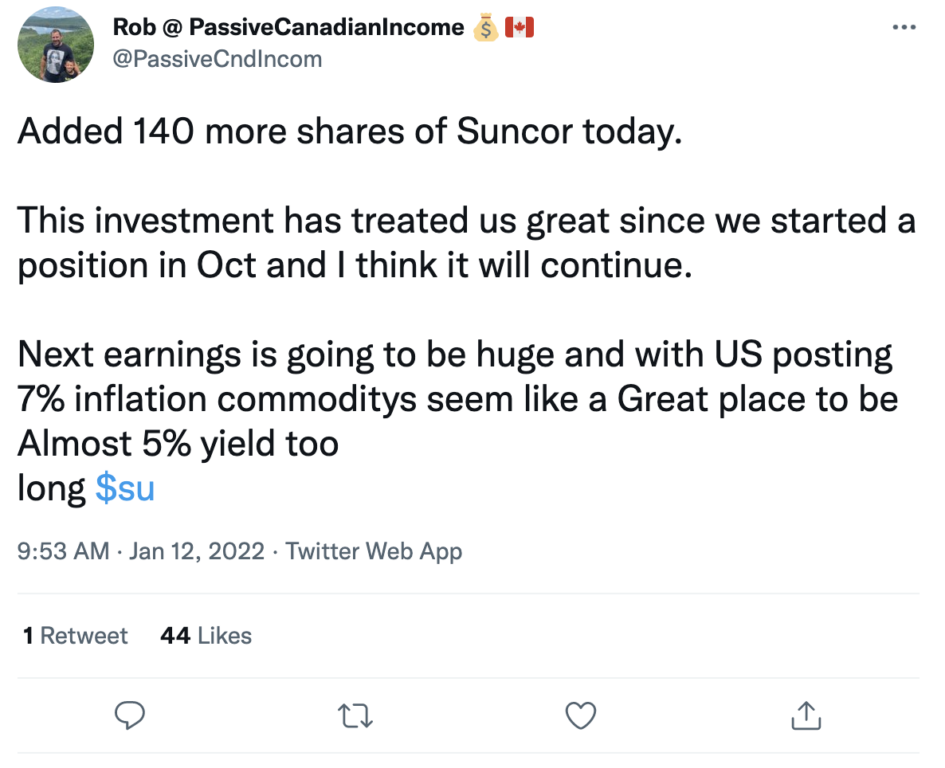Making sense of the markets this week: January 16
It’s growth vs the Fed, global dividend growth that might be topped by Canadian dividends, plus a gusher of an oil price.
Advertisement
It’s growth vs the Fed, global dividend growth that might be topped by Canadian dividends, plus a gusher of an oil price.

Cut the Crap Investing founder Dale Roberts shares financial headlines and offers context for Canadian investors
This year’s battle for the markets is shaping up. In one corner we have ongoing economic growth. In the other corner we have the Fed.
Let’s get ready to ruuuuuuummmmbbbbllllle!!!
When I made sense of 2021, we looked at commentary from LPL research that framed the growth prospects for 2022.
“An expanding economy is a great start, but stocks fundamentally derive their value from earnings. On the top line, the environment for companies to grow revenue next year should be excellent, with potential for above-average economic growth and some pricing power from elevated inflation. Revenue growth has historically been well correlated to nominal GDP growth, which is simply real GDP growth (the inflation-adjusted number that’s normally reported) plus inflation. Our 4% to 4.5% real GDP growth forecast for next year plus perhaps 3% inflation (about the consensus forecast for the increase in the Consumer Price Index) puts a 7% revenue increase in play.”
Growth prospects are more than solid for 2022. We might be in line for another year of decent returns in the markets, barring any catastrophic and surprising event, often called a black swan.
Jamie Dimon, the CEO of JPMorgan Chase, is even giddier—he recently told CNBC:
“We’re going to have the best growth we’ve ever had this year, I think since maybe sometime after the Great Depression.”
That said, one of the dominant themes from 2021 is still kicking around—that annoying thing called inflation.
It is the job of the U.S. Federal Reserve and its chair, Jerome Powell, to wrestle inflation to the ground. As I’ve said many times in this column, the main weapon of the central bankers is to raise interest rates so as to tame economic growth. If we lessen demand for products, that can help remove some of the inflationary pressures.
The risk is that they could go too far, too fast and trigger a recession.
When the Federal Reserve meeting notes were released last week, the suggestion for early rate hikes spooked the markets. Here’s a one-month chart for U.S. stocks, by way of iShares S&P 500 ETF (IVV).
Source: Seeking Alpha
Stocks were sold off somewhat aggressively but started to recover late this week. Keep in mind, as I have mentioned, that Canadian stocks continue to be on a roll as many investors rotate to the value that we find in our markets. Value equals greater current earnings plus growth prospects. Canada’s stock market is also set up well, with greater weightings to inflation-friendly assets like financials, energy and commodities.
Here’s an interesting read from Lance Roberts (no relation), chief investment strategist at RIA Advisors: Fed Minutes Spook Markets Into Selloff.
Roberts frames what’s going on with the Fed and the markets. There are some fascinating charts and tables within that post, including the returns of the Nasdaq without the top 10 stocks.
Here’s the Nasdaq 100 vs the Ark Innovation ETF (ARKK), which largely invests in growth stocks that have yet to produce earnings.
Source: RIA Advisors
Roberts’ post also includes the spooky comments from the Fed minutes, including this doozy:
“Participants remarked that inflation readings had been higher and were more persistent and widespread than previously anticipated.”
The word “participants” refers to other members of the Federal Reserve.
The remark essentially means, or could have read: “Hey, we were wrong about that transitory inflation thing.”
That reminds me of the Happy Days episode when The Fonz could not admit he was wrong or even say the word “wrong.” So maybe the Fed has Fonzie syndrome. 🙂
Another interesting chart and observation from Roberts’ post shows that years of very low volatility (2021 for instance) are often followed by years of much greater volatility.
Source: RIA Advisors
That volatility theme is playing out in early 2022. I’m guessing there is more of that to come.
Roberts also shares his asset allocation moves and tweaks. He’s a fan of owning some bonds. He’s a fan of playing some portfolio defense.
U.S. stocks have hit an all-time low with respect to the real (inflation-adjusted) earnings yield.
With economies around the globe bouncing back, the dividends will continue to flow. This piece in Seeking Alpha frames the recent dividend decline and rebound.
“After an 8% pullback in 2020, global dividend payouts resurged by 21% last year and are expected to advance 6% further this year to top $2T, IHS Markit says in a new report.”
Canadian dividend investors might be smiling as the IHS Markit research suggests energy, financials and industrials will lead the dividend charge in 2022. Canadian bank shareholders are set to receive their juicy dividend increases starting this month.
U.S. dividends are expected to increase 5.4% in 2022. I would make an easy bet that the Canadian market will trump that dividend growth rate.
Global energy dividends are expected to grow by 22%. I’d make another wager that Canadian energy producers might top that global dividend flow rate. They are just gushing free cash flow.
Here’s an insight from the Seeking Alpha post:
“Dividend growth in emerging markets is expected to outperform developed ones, rising 23% in 2022.”
Perhaps that’s a good sign for developing markets. Those indices have greatly underperformed during the pandemic.
For more on the prospects of Canadian dividend stocks, have a read of this article from Morningstar. It spoke to Les Stelmach, SVP and portfolio manager at Franklin Templeton Canada, and shared his thoughts:
“In terms of stocks, he has a favourable view on energy and financials. Within energy, he thinks investors should stick to high-quality companies with strong financial underpinnings like ARC Resources, Suncor Energy and Enbridge, which have all raised dividends recently. ‘ARC recently increased its dividend by 50% while at the same time executing on a buyback program of 10% of its outstanding shares. Similarly, Suncor has restored its dividend to its pre-COVID level, and despite some stronger momentum of late, has lagged some of its other large cap peers.’ ”
Bank of America analyst Doug Leggate also has Suncor as a top pick. So does my Twitter pal Rob, a dividend investor at Passive Canadian Income.

The Morningstar article also looks at the banks. Stelmach sees Royal Bank of Canada (RBC) as a standout:
“‘Within the banks, while we believe the group in general is attractive, we would single out RBC, which has been a recent laggard, but is attractive on our valuation work. In Information Technology, we prefer Open Text Corp, which looks attractive to us, with rising cash flows and dividends and an inexpensive valuation,’ Stelmach said.”
I’ve seen RBC making the rounds recently on many top stock lists.
Real estate investment trusts (REITs) are also mentioned as being well positioned for 2022.
After a banner 2021, it looks like we might see a repeat performance with financials, energy and REITs leading the way in 2022. Last year, I certainly offered up those sectors for consideration for investors looking to tilt their portfolios towards potential added growth and income. We might see many of the materials stocks perform well on the dividend front as well in 2022.
CVS Health has been a favourite value suggestion (by me) for a year or more. It recently raised guidance.
CVS also recently got back on that dividend increase program in healthy fashion.
With the U.S. market at historically high valuations, you might look to shade in some of these defensive names with sensible valuations. You will find many prospects in the healthcare and consumer staple sectors.
Back in November, I wrote:
“Value investing is not exclusive to cyclicals. Often, you can find value in any sector on a stock-by-stock basis. From the healthcare sector, a very defensive and non-cyclical sector, I hold CVS Health Corporation (CVS). The forward P/E ratio is 11.67 compared to 21.3 for the S&P 500, according to Seeking Alpha. A lower P/E ratio means you’re buying a stock or fund with greater current earnings. I have no problem adding money to that stock and a few others that appear (to my eye anyways) to offer greater current earnings and solid long term growth prospects.”
From the time of that column, CVS has delivered 12.5% compared to less than 1% for the S&P 500. As I’ve discussed in this column, the rotation to value is well under way.
Source: thedailyshot.com
CVS is still on my list to add to in early 2022. I have held CVS since early 2015.
The price of oil company WTI (West Texas Intermediate) broke above $80 (all figures U.S.), the highest price since early November. While oil price estimates can vary greatly, it’s not uncommon to see estimates for $100 oil for 2022.
Commodities trader Doug King tweets:
All that said, there may be a cap on the exuberance. This post on oilprice.com suggests that while oil demand will grow in 2022, production is likely to surpass demand.
From a Yahoo! Finance article:
“Oil has made a positive start to 2022 on expectations that demand will continue to expand as the pandemic’s impact on fuel consumption gradually eases, tightening the market. In the past few weeks, crude supplies from OPEC+ member nations Kazakhstan and Libya have been disrupted.
“Prices rose earlier in the session as traders focused on tightening supplies, with U.S. crude stockpiles forecast to decline for a seventh straight week.”
Eric Nuttall of Ninepoint Energy continues to see a multi-year secular bull market for oil. He also predicts (not that predictions are a tricky business) that we could see oil in the $90 to $100 range in 2022.
Scotiabank sees oil near or above $70 for several years.
National Bank has oil in the $60 to $70 range through 2024.
Here’s the link to Nuttall’s recent appearance on BNN Bloomberg.
That said, Nuttall reminds us that Canadian oil stocks do not need $100 oil to be incredibly successful. He makes a very compelling case for owning energy stocks in 2022.
The Ninepoint Energy Fund was the top-performing energy fund in the world in 2021, with returns of 186%. The oil and gas companies that Nuttall covers can pay down debt and buy themselves back (retire all their shares) within three to six years.
Here’s the recent move of the iShares ETF (XEG) that tracks the TSX capped energy index:
Source: Google
I hold XEG, plus Nuttall’s NNRG ETF, and I am looking to add a few individual large cap names for the dividend income and income growth. Canadian Natural Resources (CNQ) and Suncor (SU) would top the list.
I am above a 5% portfolio weighting in energy producers. Given that, the new additions will be modestly weighted.
Of course, do not take any of this as advice. Do your own research. Consider any stock, ETF or sector mentioned as an idea for consideration.
Dale Roberts is a proponent of low-fee investing, and he blogs at cutthecrapinvesting.com. Find him on Twitter @67Dodge for market updates and commentary, every morning.
Share this article Share on Facebook Share on Twitter Share on Linkedin Share on Reddit Share on Email